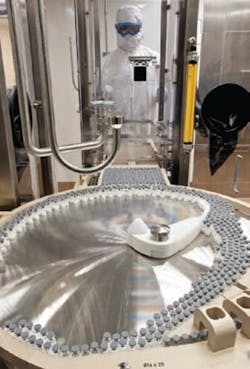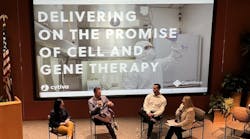In the pursuit of successful pharmaceutical enterprise, contemporary wisdom suggests that managing the complexities associated with critical preclinical developmental stages may be better left to operational experts outside one’s organization. Whatever the underlying business reason for seeking outside support, navigating a promising injectable through trial phases, then seeing it through to commercial-scale production requires intensive operational excellence to accomplish compliantly and successfully. The sky-high trajectory of biopharmaceutical development in the U.S. continues to prompt a steady and growing demand for services supporting injectables development — a promising and lucrative market that five years ago Vetter, headquartered in Germany, knew it could expand to meet, given the right operational footprint in North America.
RIGHT SPACE, RIGHT STRATEGY
In Vetter’s capabilities literature, its marketing team characterizes the company as a leader in aseptic contract filling. With more than 35 years successfully providing fill and finish services, formulation support, process development and packaging development services, Vetter’s claim of leadership is hard to dispute. The company delivers its service offerings to global customers via three primary business units: Vetter Commercial Manufacturing, Vetter Packaging Solutions and Vetter Development Service (VDS). With so many promising molecules and injectable therapies being developed out there, Vetter’s growth strategy began to focus on expanding VDS operations in the U.S.
After a thorough search process, the team — including Claudia Roth, VDS Chicago’s president — identified a promising site near Chicago. Roth explains that Vetter considered all of its options in its quest to secure lab and filling process capacity in the U.S., but quickly concluded that finding an established facility with the best combination of location, civic infrastructure, expansion potential and site-specific amenities would create the best basis for Vetter’s U.S. VDS operations. Although plenty of idle pharmaceutical capacity may be available, finding the appropriate site for VDS had its challenges, says Roth: “At that time there was not that much wet lab space available.” She says that ultimately, the former Searle campus in Skokie, Illinois, offered the best, most flexible site. The campus, now known as the Illinois Science and Technology Park (ISTP) offers tenants, according to ISTP’s website, “approximately 2 million square feet of office and state-of-the-art facilities including chemistry and biology labs, GMP and NMR facilities creating a full-service corporate research campus.” Vetter’s Skokie, Illinois, “neighborhood” is optimal in many respects. For instance, it’s a collar suburb of Chicago, has proximity to one of the nation’s biggest airports, and the geographically central region supports an ecosystem of Pharma-related businesses along with a skilled and experienced labor pool. “We liked it because of its ‘reachability,’” says Roth, noting the logistical benefits stemming from VDS’s location. “We can reach Chicago in a two- or four-hour flight from [the] coasts and we have only a seven-hour time difference from our parent company, so accessibility was good.”
Overall, Vetter’s facility encompasses about 30,000 square feet with roughly one-third dedicated to manufacturing; one-third to labs and the remaining third devoted to administration offices and warehouse space. “We had the chance to leverage the layout [because it was] a former pilot plant of Searle. But for sure, we had to fully retrofit it,” says Roth, “there was not a single piece of equipment that we could use.”
Clean Room Three contains a fully automated Bosch engineered filler dedicated to fill vials, as much as 10,000 units per batch.
One example is the original water for injection generating system Searle installed. Even though it was still functioning it was 30 years old, says Roth, and “did not have the necessary documentation, e.g., material certificates to fully qualify the system to today’s GMP standards.”
So while the layout and location were optimal, says Roth, all new process equipment had to be installed. “We started in 2010 with the retrofitting of labs and clean rooms. We also installed new utilities and our own water-for-injection generating system.” Roth points out that they used the labs to qualify the new water-for-injection facility and get ready to install the clean rooms. “It was always planned from the very beginning that we do a step-wise implementation of clean rooms,” says Roth, pointing out that VDS Chicago has a total capacity of three filling lines: the first is a multipurpose line for liquid vials, syringes and cartridges VDS installed and commissioned in 2010. In 2011, a vial line with an adjacent freeze dryer was commissioned; and in spring 2014, Vetter was busy installing its third line for syringes, which primarily enables packaging flexibility and in-line check weighing for high throughput. As of this writing, the third clean room is currently in qualification.
Roth explains that whatever is needed for incoming materials in processing, final product testing, utility testing as well as environmental testing can be accomplished by VDS Chicago labs, including some limited stability testing for customers: “What I mean by ‘limited’ is that some customers have their own stability chambers, but they do not have all the methods necessary. So they store everything and send us the samples. We perform the analysis and send the results back. If a customer wants to leverage [Vetter’s] stability program, we outsource that to our parent company, which has all the ICH conditions and very large stability chambers.”
EXCLUSIVELY SINGLE USE
Working with clients to foster their product through early development process is typically challenging because of tight timelines and the often limited amount of material to work with, notes Roth, describing Vetter’s early commitment to integrate single-use disposables into filling process operations. “We decided very early on, back in 2009, that we wanted to design the site with the exclusive use of disposables for product contact.”
“I think one of the nice things about this site is it draws people in that have varied backgrounds in [the] industry [from] the Chicago area,” says Karis Findlan, customer project manager at Vetter’s Chicago site. “A lot of us have worked together before or know people that have worked with our colleagues. A lot of people have ties to the site, as well,” she says. At her post for two years, Findlan is a Big Pharma veteran and among the frontline team customers meet to explore how Vetter’s experience and operations acumen can support their drug candidate’s development and eventual commercial potential. “We have a project management group in Germany that’s pretty large,” notes Findlan, positioning VDS Chicago operation’s within the greater Vetter organization. “It’s about 20 people. Their focus is mainly on bringing in products for commercial manufacturing. But there’s always been some clinical manufacturing occurring there as well — people want to move into their commercial site earlier, sometimes even during their clinical programs. We have two project managers here at VDS Chicago and our programs are focused on the early clinical phase — preclinical, phase I and phase II mostly. We get involved from the very beginning.”
Roth put it into perspective: “We said, ‘why start from scratch?’ Why don’t we utilize all the experience we have. We know exactly what is working in a commercial environment. We decided early on that we want to have a seamless transfer from the clinical to commercial.”
Findlan explains that it pays to get involved early, to make sure that what the customer wants is feasible for the site, “which it usually is — I think what is unique about this facility is we have a variety of types of customers. We get the large pharma who have a whole team of people and a lot of expertise … and have all the drug product experience. Some have extensive manufacturing backgrounds. [But] then you also have the very small players who may not have hands-on experience and essential technical know-how. This is their first molecule — they don’t necessarily understand supply chain.”
Squiring nascent biopharmaceutical therapies from lab to factory is a niche that VDS’s Chicago operations are geared to fill, a capability they’re eager to leverage for their customers. Findlan explains that certain customers sometimes need a bit of expectation setting when it comes to engaging a CMO/CDMO. “With the smaller start-ups some don’t realize how long it takes. They ask ‘can I fill next week? I just finished my formulation!’ They may not be aware of all the elements that go into drug product manufacturing.”
Findlan says from the first time Vetter talks to a potential customer, to the point where they are manufacturing that customer’s first GMP batch, the typical duration is about three months and that, on average, projects usually last six months, depending on different parameters.
Of course those are ball-park timelines. Roth and Findlan agree that it really depends on what stage the product is in and how much development work has already been completed. “Some people come to us with a product that they have already produced at another CMO,” says Findlan. “They have a process with some data. The first step we always take is to sit down with our process development group and [the customer] and talk about what data they have, what they know about their product, what small-scale studies they’ve done.” That all feeds, say Roth and Findlan, into how Vetter aligns its operations to meet customer needs. “Sometimes customers don’t have a lot of information,” says Roth. “So what we tend to do in that case, is talk about ways that we can approach the process [at VDS] and what we would suggest as far as a process flow and other elements. For some products, we recommend a technical batch either with API or non-GMP, or with a surrogate — especially if there’s something challenging from a formulation perspective — perhaps the API doesn’t go in a solution very easily or it requires a special suspension process.”
QUALITY: ALWAYS JOB 1
Roth says there are two main principles guiding manufacturing at VDS Chicago: “Less material and challenging timelines.” Economies are important, she said, and one of the primary reasons the facility was designed for the exclusive use of disposables for product contact. “Quality is, for sure, one of our highest, most important goals,” says Roth, pointing out that all Vetter’s filling lines are located within restricted-access barrier systems which protect the product from operators via rigid walls with steam sterilized and tested insertion gloves. “This is a very high sterility assurance level,” says Roth.
Most quality and compliance testing is accomplished on site in VDS Chicago’s microbiology lab.
Roth explains Vetter also achieves a lot of flexibility with modular systems by featuring and offering clients a variety of different component options. The same flexibility goals, she mentions, apply to primary packaging materials, as well, with Vetter able to work with vials, syringes, cartridges and other complex packaging/delivery solutions.
According to Roth, the facility’s newest clean room was deliberately configured for ready-to-use primary packaging. “I think this is a trend,” says Roth, more and more companies are starting out with ready-to-use packaging material. “On one hand this is good,” she says, “but one has to know and trust those suppliers because you are turning over all sterility-related quality assurance to them.”
Regardless of the customer’s API formulation or complexity, volume of material, or packaging plans for their product, Vetter’s intervention during preclinical to late stage development and beyond continues to prove it can help accelerate a drug’s journey to market. With its expanded capabilities in the U.S. now well established, drug sponsors have access to exceptional development and filling services to assist their effort in bringing safe, effective and new therapies to consumers.






